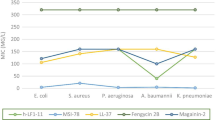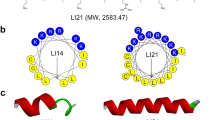Abstract
The extensive use of antibiotics for the treatment of human infections during the last few decades has led to a dramatic increase in the emergence of multidrug-resistant bacteria (MDRB) among various bacterial strains. Global research is currently focused on finding novel alternative agents with different mechanisms of action rather than the use of conventional antibiotics to counteract the threat of bacterial and biofilm infections. Antimicrobial peptides represent promising alternative agents for conventional antibiotics as these molecules display a broad spectrum of activity against several microorganisms. Recently, we have designed a novel hybrid antimicrobial peptide named MelitAP-27. This peptide has been found to display potent broad spectrum and selective in vitro antimicrobial activities against a wide range of Gram-positive and Gram-negative bacteria. In the present study, the in vitro antimicrobial and antibiofilm activities of the peptide alone and in combination with five different types of antibiotics were assessed against wild-type and resistant Gram-positive and Gram-negative bacterial strains. Our results showed that most of the combination groups displayed a synergistic mode of action against planktonic and biofilm forming bacteria which resulted in decreasing the effective MIC values for MelitAP-27 to the nanomolar concentrations. These effective concentrations were associated with negligible toxicities on mammalian cells. The results of our study indicate that combinations of MelitAP-27 with conventional antibiotics may be pursued as a potential novel treatment strategy against MDRB and biofilm forming bacteria.


Similar content being viewed by others
References
Almaaytah A, Tarazi S, Alsheyab F, Al-Balas Q, Mukattash T (2014) Antimicrobial and antibiofilm activity of mauriporin, a multifunctional scorpion venom peptide. Int J Pept Res Ther 20(4):397–408
Almaaytah A, Tarazi S, Al-Fandi M, Abuilhaija A, Al-Balas Q, Abu-Awad A (2015) The design and functional characterization of the antimicrobial and antibiofilm activities of BMAP27-melittin, a rationally designed hybrid peptide. Int J Pept Res Ther 21(2):165–177
Ceri H, Olson M, Morck D, Storey D, Read R, Buret A, Olson B (2001) The MBEC assay system: multiple equivalent biofilms for antibiotic and biocide susceptibility testing. Methods Enzymol 337:377–385
Choi KY, Chow LN, Mookherjee N (2012) Cationic host defence peptides: multifaceted role in immune modulation and inflammation. J In Immun 4:361–370
Falciani C, Lozzi L, Pollini S, Luca V, Carnicelli V, Brunetti J, Pini A (2012) Isomerization of an antimicrobial peptide broadens antimicrobial spectrum to gram-positive bacterial pathogens. PLoS One 7:e46259
Feng X, Sambanthamoorthy K, Palys T, Paranavitana C (2013) The human antimicrobial peptide LL-37 and its fragments possess both antimicrobial and antibiofilm activities against multidrug-resistant Acinetobacter baumannii. Peptides 49:131–137
Fjell CD, Hiss JA, Hancock RE, Schneider G (2012) Designing antimicrobial peptides: form follows function. Nat Rev Drug Discov 11(1):37–51
Giacometti A, Cirioni O et al (2000) In-vitro activity and killing effect of polycationic peptides on methicillin-resistant Staphylococcus aureus and interactions with clinically used antibiotics. Diagn Microbiol Infect Dis 38(2):115–118
Gould IM, David MZ, Esposito S, Garau J, Lina G, Mazzei T, Peters G (2012) New insights into methicillin-resistant Staphylococcus aureus (MRSA) pathogenesis, treatment and resistance. Int J Antimicrob Agent 39(2):96–104
Gruber I, Heudorf U, Werner G, Pfeifer Y, Imirzalioglu C, Ackermann H, Brandt C, Besier S, Wichelhaus TA (2013) Multidrug-resistant bacteria in geriatric clinics, nursing homes, and ambulant care–prevalence and risk factors. Int J Med Microbiol 303(8):405–409
Jones SM, Morgan M, Humphrey TJ, Lappin-Scott H (2001) Effect of vancomycin and rifampicin on methicillin-resistant Staphylococcus aureus biofilms. Lancet 357(9249):40–41
Komatsuzawa H, Ohta K, Sugai M, Fujiwara T, Glanzmann P, Berger-Bächi B, Suginaka H (2000) Tn551-mediated insertional inactivation of the fmtB gene encoding a cell wall-associated protein abolishes methicillin resistance in Staphylococcus aureus. J Antimicrob Chemother 45:421–431
Luca V, Stringaro A, Colone M, Pini A, Mangoni ML (2013) Esculentin (1-21), an amphibian skin membrane-active peptide with potent activity on both planktonic and biofilm cells of the bacterial pathogen Pseudomonas aeruginosa. Cell Mol Life Sci 70:2773–2786
Luna RA, Millecker LA, Webb CR, Mason SK, Whaley EM, Starke JR, Hiatt PW, Versalovic J (2013). Molecular epidemiological surveillance of multidrug-resistant Pseudomonas aeruginosa isolates in a pediatric population of patients with cystic fibrosis and determination of risk factors for infection with the Houston-1 strain. J Clin Microbiol 51(4):1237–1240
Magiorakos AP, Srinivasan A, Carey RB, Carmeli Y, Falagas ME, Giske CG, Harbarth S, Hindler JF, Kahlmeter G, Olsson-Liljequist B, Paterson DL (2012) Multidrug-resistant, extensively drug-resistant and pandrug-resistant bacteria: an international expert proposal for interim standard definitions for acquired resistance. Clin Microbiol Infect 18(3):268–281
Marr AK, Gooderham WJ, Hancock RE (2006) Antibacterial peptides for therapeutic use: obstacles and realistic outlook. Curr Opin Pharmacol 6(5):468–472
Micek ST, Wunderink RG, Kollef MH, Chen C, Rello J, Chastre J, Antonelli M, Welte T, Clair B, Ostermann H, Calbo E (2015) An international multicenter retrospective study of Pseudomonas aeruginosa nosocomial pneumonia: impact of multidrug resistance. Crit Care 19:1186
Nathwani D, Raman G, Sulham K, Gavaghan M, Menon V (2014) Clinical and economic consequences of hospital-acquired resistant and multidrug-resistant Pseudomonas aeruginosa infections: a systematic review and meta-analysis. Antimicrob Res Infect Control 3(1):1
Ouhara K, Komatsuzawa H, Kawai T, Nishi H, Fujiwara T, Fujiue Y, Sugai M (2008) Increased resistance to cationic antimicrobial peptide LL-37 in methicillin-resistant strains of Staphylococcus aureus. J Antimicrob Chemother 61:1266–1269
Rennie RP (2012) Current and future challenges in the development of antimicrobial agents. In: Coates ARM (ed) Antibiotic resistance. Springer, Berlin, pp 45–65
Spellberg B, Bartlett JG, Gilbert DN (2013) The future of antibiotics and resistance. N Engl J Med 368(4):299–302
Sueke H, Kaye SB et al (2010) An in vitro investigation of synergy or antagonism between antimicrobial combinations against isolates from bacterial keratitis. Invest Ophthalmol Vis Sci 51(8):4151–4155
Warnke PH, Lott AJ, Sherry E, Wiltfang J, Podschun R (2013) The ongoing battle against multi-resistant strains: in-vitro inhibition of hospital-acquired MRSA, VRE, Pseudomonas, ESBL E. coli and Klebsiella species in the presence of plant-derived antiseptic oils. J Cranio-Maxillofac Surg 41(4):321–326
Zasloff M (2002) Antimicrobial peptides of multicellular organisms. Nature 415(6870):389–395
Zasloff M (2016) Antimicrobial peptides: do they have a future as therapeutics? In: Harder J, Schröder JM (eds) Antimicrobial peptides. Springer, Basel, pp 147–154
Funding
This study was funded by the deanship of research at Jordan University of Science and Technology (Grant Number 288/2014).
Author information
Authors and Affiliations
Corresponding author
Ethics declarations
Conflict of Interest
All of the authors involved in this manuscript declare that they have no conflict of interest. The authors that they have no affiliations with or involvement in any organization or entity with any financial interest (such as honoraria; educational grants; participation in speakers’ bureaus; membership, employment, consultancies, stock ownership, or other equity interest; and expert testimony or patent-licensing arrangements) in the subject matter or materials discussed in this manuscript.
Ethical Approval
This article does not contain any studies with human participants or animals performed by any of the authors.
Rights and permissions
About this article
Cite this article
Almaaytah, A., Alnaamneh, A., Abualhaijaa, A. et al. In Vitro Synergistic Activities of the Hybrid Antimicrobial Peptide MelitAP-27 in Combination with Conventional Antibiotics Against Planktonic and Biofilm Forming Bacteria. Int J Pept Res Ther 22, 497–504 (2016). https://doi.org/10.1007/s10989-016-9530-z
Accepted:
Published:
Issue Date:
DOI: https://doi.org/10.1007/s10989-016-9530-z




